
Venkateswara is a form of the Hindu god Vishnu and is the presiding deity of the Venkateswara Temple, located in Tirupati, Andhra Pradesh, India. Venkateswara is also known by various other names.

Krishna district is a district in the coastal Andhra Region in Indian state of Andhra Pradesh, with Machilipatnam as its administrative headquarters. It is surrounded on the East by Bay of Bengal, West by Guntur, Bapatla and North by Eluru and NTR districts and South again by Bay of Bengal. In 2022 Krishna district was divided into Krishna and NTR districts.

Coastal Andhra or Kostandhra is a geographic region in the Indian state of Andhra Pradesh. Vijayawada is the largest city in this region. Region share borders with Uttarandhra, Rayalaseema and Telangana. It was part of Madras State before 1953 and Andhra State from 1953 to 1956. According to the 2011 census, it has an area of 91,915 square kilometres (35,489 sq mi) which is 57.99% of the total state area and a population of 34,193,868 which is 69.20% of Andhra Pradesh state population. This area includes the coastal districts of Andhra Pradesh on the Circar Coast between the Eastern Ghats and the Bay of Bengal, from the northern border with Odisha to Rayalaseema in the south.

Krishnadevaraya was an emperor of the Vijayanagara Empire reigning from 1509 to 1529. He was the third monarch of the Tuluva dynasty, and is considered to be one of the greatest rulers in Indian history. He ruled the largest empire in India after the fall of the Islamic Delhi Sultanate. Presiding over the empire at its zenith, he is regarded as an icon by many Indians. Krishnadevaraya earned the titles Andhra Bhoja, Karnatakaratna Simhasanadeeshwara, Yavana Rajya Pratistapanacharya, Kannada Rajya Rama Ramana, Gaubrahmana Pratipalaka and Mooru Rayara Ganda. He became the dominant ruler of the peninsula by defeating the sultans of Bijapur, Golconda, the Bahmani Sultanate and the Gajapatis of Odisha, and was one of the most powerful Hindu rulers in India.

Machilipatnam, also known as Masulipatnam and Bandar, is a city in Krishna district of the Indian state of Andhra Pradesh. It is a municipal corporation and the administrative headquarters of Krishna district. It is also the mandal headquarters of Machilipatnam mandal in Machilipatnam revenue division of the district. The ancient port town served as the settlement of European traders from the 16th century, and it was a major trading port for the Portuguese, British, Dutch and French in the 17th century.
Pingali Nagendra Rao, known mononymously by his surname Pingali, was an Indian screenwriter, lyricist, and playwright who worked in Telugu cinema and Telugu theatre. Famous for his witty and romantic lyrics, he also wrote dialogues for many films. Pathala Bhairavi (1951), Missamma (1955), and Mayabazar (1957) are some of his best known works for story, script and song lyrics. Pingali is famous for his coining of new and funny words and phrases in Telugu such as Dhimbaka, Dingari, Gimbali.

Telugu literature is the body of works written in the Telugu language. It consists of poems, short stories, novels, plays, and song lyrics, among others. There is some indication that Telugu literature dates at least to the middle of the first millennium, the first extant works are from the 11th century when the Mahabharata was first translated to Telugu from Sanskrit by Nannaya but there were signs that Telugu literature was already existing. The language has experienced a golden age under the patronage of the Vijayanagara Emperor-Poet Krishnadevaraya.

Salihundam, is a village and panchayat in Gara Mandal of Srikakulam district in Andhra Pradesh. It is a historically important Buddhist monument of ancient Kalinga and a major tourist attraction It is a village lying on top of the hill on the south bank of the Vamsadhara River. It is at a distance of 5 KM west to Kalingapatnam and 10 KM from Singupuram and 18 KM from Srikakulam town. It was known as Salipetaka.

Rao Venkata Kumara Mahipati Surya Rau CBE (1885–1964) was Maharajah of Pithapuram. He was called by Telugu people "Abhinava Krishnadevaraya". Maharani Sita Devi of Baroda was his daughter.

Kalyanam Raghuramaiah (1901–1975), popularly known as Eelapata Raghuramaiah, was an Indian actor, and thespian known for his works in Telugu cinema, and Telugu theatre. A recipient of the Sangeet Natak Akademi Award, and the Padmashri, He was known for the roles of Krishna or Dushyantha, Bhavanisankar, Narada etc. He performed those roles for about 60 years. He indulged in elaborate raga alapana, based on different ragas while rendering padyams.

Gudlavalleti Chalapati Rao or Gudlavalleti Venkata Chalapati Rao was a noted writer, philosopher and an ex Deputy commissioner of Endowments Department in the Government of Andhra Pradesh. He was born in 1915 at Gudlavalleru, Krishna District, Andhra Pradesh to Venkata Ramaih Gudlavalleti and Suryakantham Gudlavalleti. He graduated from Andhra University and also took a law degree from Madras University. After his education, he served in the Revenue, Employment & Training and Endowments Departments, finally retired as Selection Grade Deputy Collector, finally settling down at Machilipatnam, Andhra Pradesh. He was married to Krishnaveni amma Gudlavalleti and has three sons and a daughter.

Kasula Purushottama Kavi was a Telugu poet who lived during the late 18th century. His parents were Kasula Appalaraju and Ramanamma. He hailed from the Diviseema area of Krishna District, Andhra Pradesh. He was a court poet of the then-Raja of Challapalli, Yarlagadda Ankineedu Prasad I of the Challapalli Samasthanam and possibly of his father as well. Purushottama Kavi is recognized for composing literary works in Telugu consisting of one hundred poetic stanzas, known as satakams.
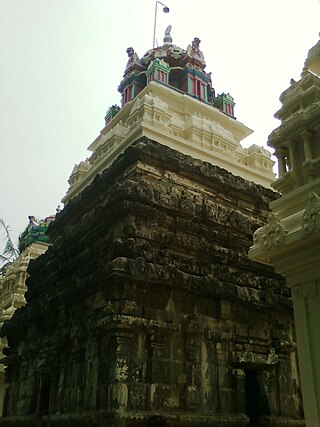
Srikakulam is a village located in Ghantasala Mandal in Diviseema region of Krishna District, Andhra Pradesh. According to Inscription of Kapilendra Deva the deity of the temple named as Sri Ballava swamy.
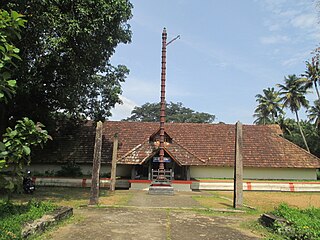
The Thrichittatt Mahavishnu Temple is a Hindu temple dedicated to Vishnu,located in Chengannur, Alappuzha District, Kerala, South India. Constructed in the Kerala style of architecture, the temple is glorified in the Nalayira Divya Prabandham, by Nammalvar, one of the Sri Vaishnava saint-poets of the 8th century called the Alvars. It is one of the 108 Divya Desams dedicated to Krishna, an avatar of Vishnu, who is worshipped as Imayavarappan. The nearest railway station to the temple is located in Chengannur, while the nearest airports are Trivandrum International Airport and Nedupumpassery Airport Ernakulam.
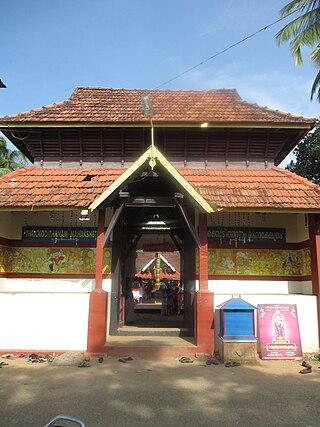
Thrikodithanam Mahavishnu Temple is a Hindu temple dedicated to Vishnu and located in Thrikkodithanam, Kottayam District, Kerala, South India. Constructed in the Kerala style of architecture, the temple is glorified in the Nalayira Divya Prabandham, the early medieval Tamil canon of the Alvar saints from the 6th–9th centuries CE. It is one of the 108 Divya Desam dedicated to Krishna, an avatar of Vishnu, who is worshipped as Mahavishnu. The nearest railway station to the temple is located in Changanassery, while the nearest airport is Cochin International Airport.

The Āmuktamālyada is a Telugu epic poem composed by Krishnadevaraya, the ruler of the Vijayanagara Empire, in the early 16th century. Amuktamalyada translates to "One who offered the garland after wearing it himself". Considered as a masterpiece, the Amuktamalyada describes the legendary wedding of the Hindu deity Ranganayaka, an avatar of Vishnu, and Andal, one of the poet-saints called the Alvars, at Srirangam.

The Kurmanathaswamy temple, also known as the Kurmanatha temple, Srikurma or Srikurmam temple, is a Hindu temple dedicated to Kurma – the second avatar of Vishnu. It is located in Srikurmam village, Srikakulam district in Andhra Pradesh, India. According to Prapannamrutam and earliest inscription of the temple, In saka 1035 CE Anantavarman Chodaganga Deva of Eastern Ganga Dynasty of Odisha converted this temple to a Vaishnava khetra from a Siva temple.The temple was Built before 11th-century AD in a fusion architecture of kalinga Architecture and Dravidian Architecture. The temple's perambulatory were constructed by Eastern Ganga Dynasty king Anangabhima Deva III , and it is dedicated to Vishnu as Kurmanathaswamy and his consort Lakshmi as Kurmanayaki. The temple has century old Orissan Pattachitra style mural paintings in side wall of pradakshina mandapa.

Vavilikolanu Subba Rao or Andhra Valmiki or Vaasu Daasa Swami was a Sanskrit scholar and a Telugu poet, often known by the epithet Andhra Valmiki.
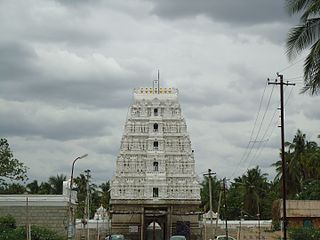
Sri Venugopalaswamy Temple is a Hindu-Vaishnavite temple situated at Karvetinagaram in, Chittoor District of Andhra Pradesh state, India. The Temple is dedicated to Lord Krishna, ninth incarnation of Vishnu's Dasavatharam, who is referred to as Venugopala. It is situated at a distance of 58 km from Tirupati and 12 km from Puttur.
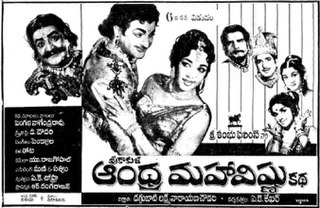
Srikakula Andhra Maha Vishnu Katha is a 1966 Indian Telugu-language historical drama film, based on the life of Andhra Vishnu, produced by Daggubati Lakshminarayana Chowdary under the Sri Sambhu Films banner and directed by A. K. Sekhar. It stars N. T. Rama Rao and Jamuna, with music composed by Pendyala Nageswara Rao.
Srinivas, Sistla., (Tr.) Sri Krishna Deva Raya's Amuktamalyada, Visakhapatnam, 2010.





























